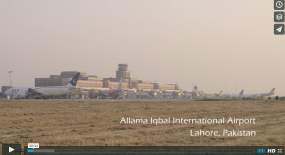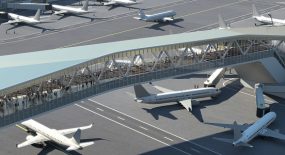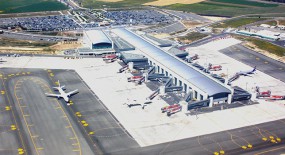
Making airports operate in a greener way has been the leitmotif for airport operators for many years. On one hand, the community demands airports decrease their environmental impact on surrounding neighbourhoods, and on the other hand, communities need well-greased transportation systems to survive and prosper in a globalized world.
Environmental impacts of air traffic growth
With a worldwide average growth of air travel in the region of 4-5% per annum over the next 20 years, it is projected that more than 1000 new international airports (not existing today) will be required. Most of the air traffic growth is expected to occur in or near metropolitan areas.
This will increase the number of people living close to or in the vicinity of an airport. To accommodate a new airport a substantial area of land is required. This normally equates to positioning the airport outside the city in a more rural area where land is available to accommodate the needs of an airport.
An airport handling international traffic will attract external businesses that either provide services directly to the airport, or indirectly through subservices connected to trade or infrastructure. The airport itself will also need a lot of employees that do not want to commute for long periods of time to reach their work place. This will create a big demand for land close to the airport to lodge both businesses and housing for the airport workforce. Over time this will expose a considerable amount of people to the airport environment both during work hours and free time.
The environmental impact of an airport on the local community is not a new consideration. This is something airport managements have had on their agenda for years. Local and national environmental organisations are demanding the aviation industry (often projected directly to the airport itself) reduce noise and air pollution to the benefit of the community close to the airport. Conversely, the necessity for the community to have a well-functioning transportation port is vital for a society that is more and more dependent on the global exchange of goods and services, and international travel for people.
New technical solutions hand-in-hand with positive environmental impact
One of ADB SAFEGATE’s three key missions is to provide technical solutions that will support both the community’s needs and the airport’s needs in decreasing the airport airside environmental impact.
Increasing airport efficiency and safety – two more of ADB SAFEGATE’s key missions – in many cases go hand-in-hand with the reduction of environmental impact. If a technical solution or an operational change makes the airport more efficient, it will also positively benefit the environment. The advent of airport cross-border integration (integration of systems between different organisations at the airport) has shown to be one of the most beneficial ways of increasing airport efficiency while also decreasing environmental impact.
Benefits of cross-border integration include better and more efficient handling through active guidance of aircraft between terminal buildings and runways. Real-time and active guidance of aircraft can reduce taxi times by several minutes for each flight.
Every minute that can be reduced in taxi time equates to less aircraft fuel burn and in turn will directly reduce the CO2 emissions and noise emissions for that flight. One minute may not sound like much. But at an airport with 100,000 movements per year, that equals 100,000 fewer minutes of fuel burn, and lower CO2 and noise emissions. Lower fuel burn also equates to a lot of savings for the airlines at the airport.
“The advent of airport cross-border integration has shown to be one of the most beneficial ways of increasing airport efficiency and while also decreasing environmental impact.”
Another benefit of cross-border integration is apparent at the gate area, where monitoring of the use of ground power to the aircraft will effectively reduce the time an APU (Auxilary Power Unit – a small jet engine providing power to the aircraft during ground stop) is in use. Ground power supplied from the airport power grid is a much greener way of providing power during the turn around of the aircraft at the gate or remote stand. In a normal case, the cross-border integration and monitoring reduce the usage of APU with 10-20 minutes per turnaround. This reduction of APU usage directly equates to less fuel burn, less CO2 and noise emissions, and fuel savings.
There are benefits to living in a community close to an airport, and there are also downsides – it can be a constant battle. If there is one single objective that unites the two sides of the coin, it must be the drive to make airports greener. With the rapid growth projected for traffic over the next 20 years, it will become more and more vital for airports – both existing and new – to find a balance between becoming more efficient, maintaining safety, and managing their environmental impact. Cross-border integration unites these areas and allows airports to manage traffic growth while still being green.
Written by Roy Bolwede, General Manager at ADB SAFEGATE and expert in ATM & Airport Operations Solutions
For more information contact Roy Bolwede: roy.bolwede[a]adbsafegate.com
ADB SAFEGATE is a leading provider of intelligent solutions that deliver superior airport performance from approach to departure. The company partners with airports and airlines to analyze their current setup and operations, identify bottlenecks, and jointly solve them using a consultative approach that enables airports to improve efficiency, enhance safety and environmental sustainability, and reduce operational costs. Our integrated portfolio includes solutions and services that harmonize airport performance, tackling every aspect of traffic handling and guidance, from approach, runway and taxiway lighting, to tower-based traffic control systems, and intelligent gate and docking automation. ADB SAFEGATE has more than 900 employees in more than 20 countries and operates in more than 175 countries, serving more than 2,000 airports.















Leave a Comment